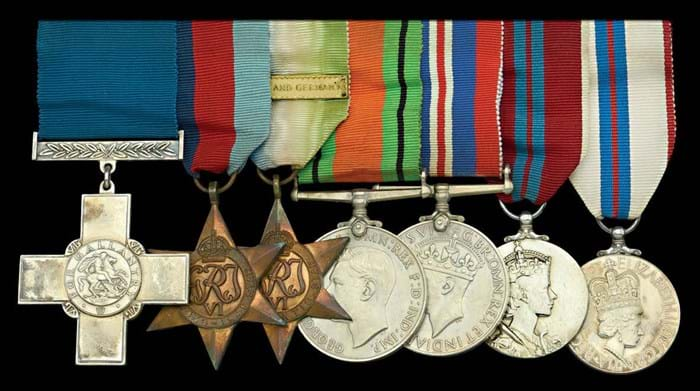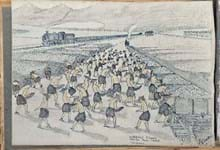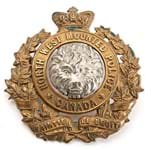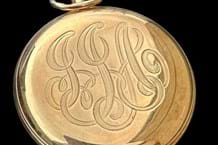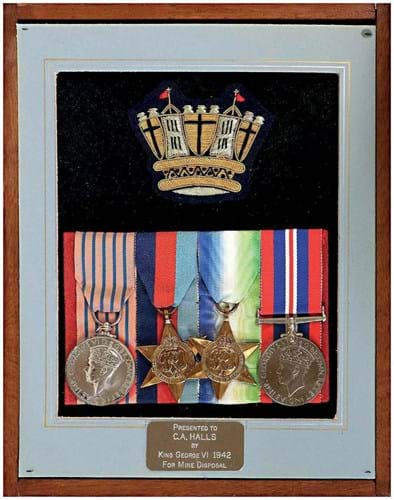
Second World War group of four medals including George Medal awarded to Charles Halls, £3600 at Tennants.
Such was the case with a Second World War group of four medals estimated at £2000-3000 in Tennants’ (24% buyer’s premium) auction on March 20.
Charles Albert Halls volunteered to work on mine disposal while serving in the Royal Navy in 1942. He had been serving on HMS Manchester, escorting convoys in the North Sea as far as Greenland.
Following a training course, he was posted to the Admiralty and spent the next 18 months defusing mines on land. Sea mines, which were also used by the Germans as land mines, were dropped with a parachute from enemy planes. These mines, which were 8ft long and weighed a ton, hit the ground at 40mph acting like a bomb. They were often booby trapped in case they did not explode on impact.
It was a very skilful and dangerous job to deactivate them. Halls deactivated 15 and was awarded the GM for tackling two very difficult examples, one being at Charing Cross Station.
His GM and wartime service medals were offered in a glazed display showing a Merchant Navy insignia, with a book Military Voices Past and Present, West Sussex Veterans in the 20th Century in which Halls’ exploits are described.
The lot sold to a UK buyer for £3600, with UK online and commission private and trade bidding.
Buried alive
A ‘London Blitz’ George Cross – the civilian equivalent of the Victoria Cross – awarded to Sub Lieutenant Jack Maynard Cholmondeley Easton of the Royal Naval Volunteer Reserve will be offered at Noonans in Mayfair on April 10.
Estimated at £80,000-120,000, it is being sold on behalf of a deceased estate.
Easton was a member of the Admiralty’s secretive Land Incident Section. He was buried alive by the detonation of a parachute mine in London’s East End in October 1940. When eventually pulled from the debris, he was found to have suffered a fractured skull, a broken back, and broken legs. Easton made a full recovery. His gallant assistant – Ordinary Seaman Bennett Southwell – was less fortunate, his decapitated body being discovered six weeks later.
Nimrod Dix, head of medal department and deputy chairman of Noonans, said: “The Second World War was really the first war that civilians were on the frontline in the cities that were being attacked during the Blitz. As a result of this, it was decided that there was a need for a new gallantry award and the George Cross was introduced by George VI in 1940.”
He added: “Easton was no stranger to the nerve-wracking business of mine disposal, having earlier made safe 16 such devices, including one which had crashed through the roof of the Russell Hotel in Bloomsbury and ended up hanging from the chandelier in the main dining room: the grateful hotel owner presented Easton with a cheque for £140 – and an offer of Sunday lunch for his family for life – but both had to be rejected ‘as a matter of honour’.”
Remarkably, after a year in plaster, Easton made a full recovery, although on being discharged from hospital he had lost all his hair. As it happened, the head of L’Oreal, the beauty products company, was a client of the family law firm and he was duly consulted for advice: after daily administering the recommended – but far from pleasant – concoction to his scalp, Easton was delighted to see the gradual return of his hair.
Better still was the news of his GC. The Admiralty sent round three cases of champagne to his hospital and told him to listen to the 6pm news, in which the award was announced; he was invested by King George VI at Buckingham Palace on September 23, 1941.

Sub Lieutenant Jack Maynard Cholmondeley Easton.
Easton subsequently served as First Lieutenant of the motor minesweepers MMS 6 (June -August 1942) and MMS 66 (August 1942-February 1943), prior to taking command of the MMS 22 in the latter month. He led a minesweeping flotilla off Normandy in June 1944, when a new type of German oyster mine detonated under his ship and wounded him for a second time.


